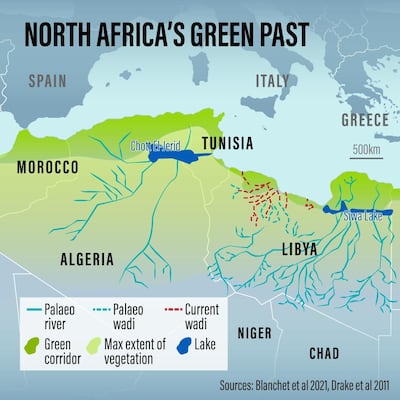The Sahara is one of the most inhospitable places on the planet. Stretching 9,200,000 square kilometres across North Africa, it is the largest hot desert in the world. But as recently as 6,000 years ago, it was teeming with life.
Research recently published in Nature Geoscience uncovers the nature of this and other "greening phases", occurring every 20,000 years and lasting approximately 5,000, when the desert was brought to life.
Through drilling up sediment cores in the Gulf of Sirte off the coast of Libya, an international research team, led by Cecile Blanchet of the GFZGerman Research Centre for Geosciences, have been able to extend the hydroclimate record back 160,000 years, much further than previous records of the region.
“We were twice lucky,” Ms Blanchet says of the coring expedition, which began in 2011 with a hunch and was meant to be a pilot study for future research. “We were lucky to be able to go there and we were lucky to have good cores.”
For some time scientists have known, through cave art and other archaeological evidence, that humans lived and thrived in what is now the desert. They had also theorised that extinct rivers and streams crisscrossed parts of present-day Libya, Tunisia and Algeria. But until now there had been little way of knowing exactly when and why these rivers began to flow. The muddy sediments pulled up from the Mediterranean sea floor would provide answers.
Blanchet and her colleagues used radiocarbon and other dating methods on four particularly revealing sediment cores, as well as computer modelling, to comprehensively reconstruct how rainfall throughout the region shifted seasonally and shaped extensive river systems over thousands of years.
The green Sahara
What is now an arid sea of sand and stone would have, at its greenest, resembled the verdant savannahs of today’s southern Sahel as a result of monsoon rains reaching all the way north to the Mediterranean coast. The Nile River and its already expansive watershed was even greater, and ran adjacent to several other large, perennial rivers across the region, nurturing flora and fauna as they flowed.
“There would have been a window of opportunity where people could live for thousands of years in this space,” Ms Blanchet posits. At the peak of these humid phases, “green corridors” would have stretched from Morocco to the Levant, allowing movement and mixing of early humans.
The oldest Homo sapiens fossils – fragments of skull, face and jaw bones found in Morocco – have been dated at about 300,000 years old. Ms Blanchet hopes the team’s continuing research can contribute to the understanding of how humans came to be by extending the record back even further.
“For us and for paleoanthropologists, it will be important to take this record back to 400,000 so that we have a good idea about when these rivers were flowing and what sort of environment [early humans] had.”
Will life return to the desert?
As for the near future, things are a bit more murky. "Our research doesn't provide any clues for [near-term] forecasting, because we're talking about changes that occur over very long time periods," Ms Blanchet says. Short of waiting another 10,000 years or so for the next greening phase, it is hard to predict whether the drought-stricken region will see relief any time soon. But one thing is certain – climate change is making things more unpredictable.
“What we do know is that this region will probably suffer from water scarcity, especially in the Levant, but North Africa is also quite sensitive.”
Variability in rainfall is likely to increase. The ongoing Nile Dam dispute is only one instance of the sort of conflict that can arise when water is in short supply.
“We are playing with fire, definitely,” Ms Blanchet says.
As nations fight over what little water is left, North Africa’s fossil rivers tell a cautionary tale.


